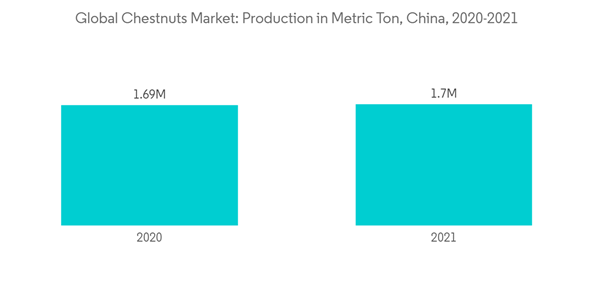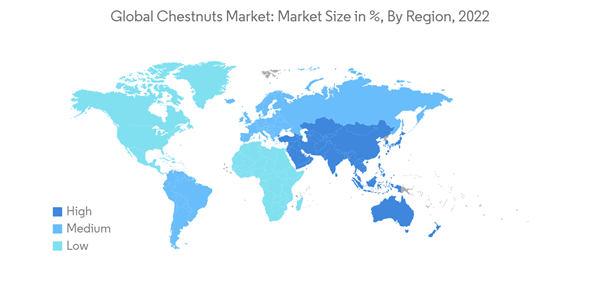The global chestnut market is estimated to register a CAGR of 3.1% during the forecast period.
The American Heart Association promotes chestnuts as a high carbohydrate, low fat, low sodium diet as a principal defense against heart disease. The demand for chestnuts is increasing significantly due to their various health benefits. There is an increased use of chestnuts in confectionery as they are an excellent source of several nutrients such as vitamin C, B1, B2, and B6; folic acid; manganese; copper; and magnesium, and thus are anticipated to boost the growth of the chestnuts market.
Various countries import from countries like China, which has abundant production. Thus, making China a leading exporter of chestnuts. According to ITC Trade, China exported USD 70,682 thousand worth of chestnuts in 2021. Due to these benefits, the demand for chestnuts is high in many countries where production is considerably less like Germany, the United States, etc., thus creates a massive opportunity for export.
For many years, China has loomed as one of the largest bowls of Chinese chestnut in the world. Although the consumption of chestnut has increased in India too in the states like Uttarakhand which shares a border with China. Recent programs have mandated the large-scale establishment of chestnut orchards in many different regions of China in order to develop the market value of the country and create an opportunity to grow the sector during the forecasting period.
According to ITC Trade, in 2021, China accounted for the highest share of the total export across the world, with export revenue of USD 70,682 thousand. China produces alone more than 75 % of the world's chestnut, followed by Bolivia, Turkey, South Korea and Italy. Major export destinations for Chinese chestnuts are Thailand, Viet Nam, Taiwan, and Japan. Vietnam is the major importer accounting for revenue of USD 13,338 thousand with an import quantity of 5,681.7 metric ton in 2021.
This product will be delivered within 2 business days.
Key Highlights
- The chestnut is the most useful tree in the world and has a nutritional composition that sets them apart from all other nuts. Chestnuts are very low in fat and higher in starch than other nuts, making them less caloric. The rich nutritional content is increasing the demand for chestnuts globally and will drive the growth of the market in the coming years. There are 4 major species - American Chestnut (Castanea dentata), European Chestnut (C. sativa), Chinese Chestnut (C. mollissima), and Japanese Chestnut (C. crenata) and 9 less important species of the genus Castanea in the world.
- Asia is the largest producer and consumer of chestnuts in the world. China and Korea are the largest producers of chestnuts in the region. The Chinese chestnut has a flavorful nut and is resistant to chestnut blight so, Korea grows Chinese-Japanese cultivars in order to resist those diseases. Japan is also a major consumer of chestnuts, however, Japanese nuts do not have nearly as good a flavor as Chinese nuts, although being large.
- The application of chestnut flour in baked products is also growing, which in turn is driving the production and export market for chestnuts across the world. According to the Food and Agriculture Organization, China, Bolivia, Greece, Italy, Portugal are the significant chestnut producers in the world.
Chestnuts Market Trends
Increasing Demand Due to the Nutritional Benefits
Chestnut is known as the bread tree and it has a been staple in the diet of people all over the world for thousands of years. It is a high-quality food source, with the nutritional makeup of a grain. Nutritionally, chestnuts contain 40-45% carbohydrates, 5-8% protein, 2-3% fat, and the balance is water. The protein is very high quality, with an amino acid balance similar to milk or egg. They contain high amounts of Tryptophan, Isoleucine, Lysine, linoleic acid, and sulfur-containing amino acids. Chestnuts are gluten-free and can be incorporated into many foods as a gluten-free flour substitute.The American Heart Association promotes chestnuts as a high carbohydrate, low fat, low sodium diet as a principal defense against heart disease. The demand for chestnuts is increasing significantly due to their various health benefits. There is an increased use of chestnuts in confectionery as they are an excellent source of several nutrients such as vitamin C, B1, B2, and B6; folic acid; manganese; copper; and magnesium, and thus are anticipated to boost the growth of the chestnuts market.
Various countries import from countries like China, which has abundant production. Thus, making China a leading exporter of chestnuts. According to ITC Trade, China exported USD 70,682 thousand worth of chestnuts in 2021. Due to these benefits, the demand for chestnuts is high in many countries where production is considerably less like Germany, the United States, etc., thus creates a massive opportunity for export.
Asia- Pacific Dominates the Market
According to FAO, the leading producers of the market are China, Korea, and Japan in 2022. The export market is growing at a significant pace due to the growing demand for chestnuts across the region which will further tend to develop and grow the market in the coming years.For many years, China has loomed as one of the largest bowls of Chinese chestnut in the world. Although the consumption of chestnut has increased in India too in the states like Uttarakhand which shares a border with China. Recent programs have mandated the large-scale establishment of chestnut orchards in many different regions of China in order to develop the market value of the country and create an opportunity to grow the sector during the forecasting period.
According to ITC Trade, in 2021, China accounted for the highest share of the total export across the world, with export revenue of USD 70,682 thousand. China produces alone more than 75 % of the world's chestnut, followed by Bolivia, Turkey, South Korea and Italy. Major export destinations for Chinese chestnuts are Thailand, Viet Nam, Taiwan, and Japan. Vietnam is the major importer accounting for revenue of USD 13,338 thousand with an import quantity of 5,681.7 metric ton in 2021.
Additional Benefits:
- The market estimate (ME) sheet in Excel format
- 3 months of analyst support
This product will be delivered within 2 business days.
Table of Contents
1 INTRODUCTION
4 MARKET DYNAMICS
5 MARKET SEGMENTATION
Methodology

LOADING...










